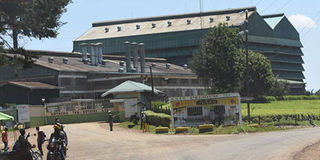Moi’s penchant for names from his Kabarnet background

Kiptagich Tea Factory which is named after a village neighbouring Kabarak in late former President Daniel arap Moi's rural home. Moi always ensured he left significant imprints linked to his birthplace wherever he made investments. PHOTO | FILE | NATION MEDIA GROUP
What you need to know:
- Moi acquired the expansive 3,000-acre Kabarak farm from a white settler.
- He set up Kabarak School and University within his farm in Nakuru.
- Moindi said Moi was instrumental in guiding the growth and stability of Sacho High School.
Former President Daniel arap Moi did not forget his roots in Kabarnet, Baringo County, always ensuring he left significant imprints linked to his birthplace in areas he moved to later in his life.
In some of the areas he made big investments, he gave the businesses names from Kabarnet, an indication that he adored his roots and appeared to seek to engrave them in more durable interests, possibly for future generations to remember him and where he came from.
For a start, the Kabarnet Gardens, his private home along Ngong Road in Nairobi, is named after the most developed town in Baringo.
Kabarnet town is presently the county headquarters and was one of the places Moi is said to have spent time meeting locals when he visited his rural home.
LEGCO MEMBER
Moi represented the area first as a member of the Legislative Council (Legco) (1955-1962) and then as MP for Baringo North (1963-1967) and finally Baringo Central (1967-2002).
Kabarnet got its name from a revered missionary, Albert Edmund Barnett, who set base in the town in 1908 and lived there for years, earning the respect of locals.
Moi also named his residence in Nakuru Kabarak, after a village by the same name in Sacho-Mosop Location in Baringo Central Constituency where he was born in 1924.
His relatives have disputed the year saying he was born earlier.

Moi receives a gift from students of Moi High School Kabarak in 2009. PHOTO | FILE | NATION MEDIA GROUP
KABARAK
Moi acquired the expansive 3,000-acre Kabarak farm from a white settler following a decree by President Jomo Kenyatta after independence in 1963 that enabled natives to buy land from the white settlers who were leaving the country.
In 2018, he got exclusive trademark rights for the name Kabarak following a successful application to the Kenya Industrial Property Institute (Kipi).
After establishing a tea factory in Kuresoi in Nakuru, he named it Kiptagich Tea Factory, yet again after a village neighbouring Kabarak in his rural home but still within Sacho-Mosop Location.
Kiptagich Tea Estates Limited was established in 1978 and commissioned in 1995.
NEVER FORGOT ROOTS
Sacho-Mosop Location Chief Philip Korir, a grandson of Mr Tuitoek Moi -- the elder brother of the former President -- said Moi never forgot his roots and, although he moved to Kabarak in Nakuru and spent most of his time there, he never severed his links with Sacho in Kabarnet.
“He never forgot his rural home. He always took the names of the places here to where he lived, away from the rural home. This clearly shows he loved Kabarnet and appreciated our names,” Mr Korir told the Nation.
Perhaps the only place he did not replicate is Kurieng’wo, the exact area where he was born before the family moved to the adjacent Kabarak village after colonial officers asked them to shift to give room for conservation of the forest.
Other than carrying with him names from his place of birth, Moi replaced them with massive resources directed to the area in the 24 years he was in power.
INFRASTRUCTURE
The resources were mostly to improve education infrastructure and, to date, dozens of schools, some iconic, built during his reign dot the area.
Sacho High School, built within Kabarak village — which is still one of the most remote places in Baringo — is probably one of the significant infrastructural achievements that elevated the place to recognisable standards.
Although the school, built in 1982, is no longer the consistently high-performing national school as it was before, it is still a learning institution of choice for hundreds of students from the region.

A flag flies at half-mast at Sacho High School in Baringo County on February 4, 2020 following the death of former President Moi. Moi started the school in 1982. PHOTO | JARED NYATAYA | NATION MEDIA GROUP
SCHOOL'S STABILITY
The school’s general manager, Mr Richard Moindi, said Moi was instrumental in guiding the growth and stability of the school.
“His death has left a huge gap but his legacy will live on,” said Mr Moindi when he joined students to mourn Mzee Moi on Tuesday.
Moi also built Tabagon Girls' School, not far from Sacho, in honour of his mother, Kabon Chebii, who hailed from the area.
Other schools spread across the region that were built through direct intervention of the former Head of State are Moi School Kabartonjo, Moi Girls Eldoret, Moi Tea Girls in Kericho, Moi Girls Kapsowar in Elgeyo-Marakwet and Moi Siongiroi in Bomet, among others.
He also set up Kabarak School and University within his farm in Nakuru. The two institutions are managed by his family.





